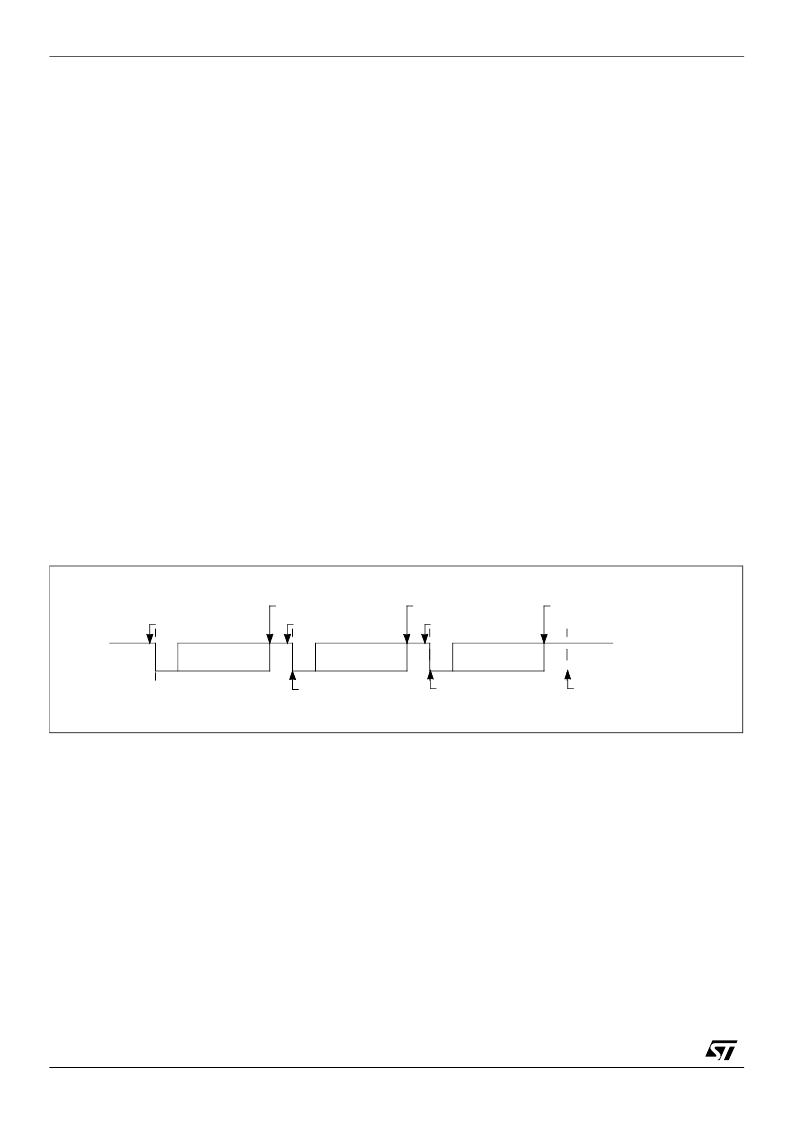- 您現(xiàn)在的位置:買賣IC網(wǎng) > PDF目錄383838 > ST20GP1 MAX 7000 CPLD 256 MC 208-PQFP PDF資料下載
參數(shù)資料
| 型號(hào): | ST20GP1 |
| 英文描述: | MAX 7000 CPLD 256 MC 208-PQFP |
| 中文描述: | GPS處理器 |
| 文件頁數(shù): | 79/116頁 |
| 文件大小: | 1107K |
| 代理商: | ST20GP1 |
第1頁第2頁第3頁第4頁第5頁第6頁第7頁第8頁第9頁第10頁第11頁第12頁第13頁第14頁第15頁第16頁第17頁第18頁第19頁第20頁第21頁第22頁第23頁第24頁第25頁第26頁第27頁第28頁第29頁第30頁第31頁第32頁第33頁第34頁第35頁第36頁第37頁第38頁第39頁第40頁第41頁第42頁第43頁第44頁第45頁第46頁第47頁第48頁第49頁第50頁第51頁第52頁第53頁第54頁第55頁第56頁第57頁第58頁第59頁第60頁第61頁第62頁第63頁第64頁第65頁第66頁第67頁第68頁第69頁第70頁第71頁第72頁第73頁第74頁第75頁第76頁第77頁第78頁當(dāng)前第79頁第80頁第81頁第82頁第83頁第84頁第85頁第86頁第87頁第88頁第89頁第90頁第91頁第92頁第93頁第94頁第95頁第96頁第97頁第98頁第99頁第100頁第101頁第102頁第103頁第104頁第105頁第106頁第107頁第108頁第109頁第110頁第111頁第112頁第113頁第114頁第115頁第116頁

ST20-GP1
79/116
13.4.1 Using the ASC interrupts
For normal operation (i.e. besides the error interrupt) the ASC provides three interrupt requests to
control data exchange via the serial channel:
TxBufEmpty
is activated when data is moved from
ASCTxBuffer
to the transmit shift reg-
ister.
TxEmpty
is activated before the last bit of a frame is transmitted.
RxBufFull
is activated when the received frame is moved to
ASCRxBuffer
.
The transmitter generates two interrupts. This provides advantages for the servicing software.
For single transfers it is sufficient to use the transmitter interrupt (
TxEmpty
), which indicates that
the previously loaded data has been transmitted, except for the last bit of a frame.
For multiple back-to-back transfers it is necessary to load the next data before the last bit of the
previous frame has been transmitted. This leaves just one bit-time for the handler to respond to the
transmitter interrupt request.
Using the transmit buffer interrupt (
TxBufEmpty
) to reload transmit data allows the time to transmit
a complete frame for the service routine, as
ASCTxBuffer
may be reloaded while the previous
data is still being transmitted.
As shown in Figure 13.5 below,
TxBufEmpty
is an early trigger for the reload routine, while
TxEmpty
indicates the completed transmission of the data field of the frame. Therefore, software
using handshake should rely on
TxEmpty
at the end of a data block to make sure that all data has
really been transmitted.
Figure 13.5 ASC interrupt generation
13.5 ASC configuration registers
ASCBaudRate register
The
ASCBaudRate
register is the dual-function baud rate generator/reload register.
A read from this register returns the content of the timer, writing to it updates the reload register.
An auto-reload of the timer with the content of the reload register is performed each time the
ASCBaudRate
register is written to. However, if the
Run
bit of the
ASCControl
register, see Table
13.5, is 0 at the time the write operation to the
ASCBaudRate
register is performed, the timer will
not be reloaded until the first CPU clock cycle after the
Run
bit is 1.
Idle
Idle
S
S
S
S
S
S
TxBufEmpty
TxEmpty
TxBufEmpty
TxBufEmpty
TxEmpty
TxEmpty
RxBufFull
RxBufFull
RxBufFull
相關(guān)PDF資料 |
PDF描述 |
|---|---|
| ST20GP6 | MAX 7000 CPLD 256 MC 208-RQFP |
| ST25C02AB1 | IC FLEX 6000 FPGA 16K 144-TQFP |
| ST25C02AB6 | Stratix FPGA 25K FBGA-672 |
| ST25C02AM1 | IC ACEX 1K FPGA 100K 208-PQFP |
| ST25C02AM6 | Cyclone II FPGA 20K FBGA-256 |
相關(guān)代理商/技術(shù)參數(shù) |
參數(shù)描述 |
|---|---|
| ST20-GP1 | 制造商:STMICROELECTRONICS 制造商全稱:STMicroelectronics 功能描述:GPS PROCESSOR |
| ST20GP1X33S | 制造商:STMICROELECTRONICS 制造商全稱:STMicroelectronics 功能描述:GPS PROCESSOR |
| ST20GP6 | 制造商:未知廠家 制造商全稱:未知廠家 功能描述:GPS PROCESSOR |
| ST20-GP6 | 制造商:STMICROELECTRONICS 制造商全稱:STMicroelectronics 功能描述:GPS PROCESSOR |
| ST20GP6CT33S | 制造商:STMICROELECTRONICS 制造商全稱:STMicroelectronics 功能描述:GPS PROCESSOR |
發(fā)布緊急采購(gòu),3分鐘左右您將得到回復(fù)。